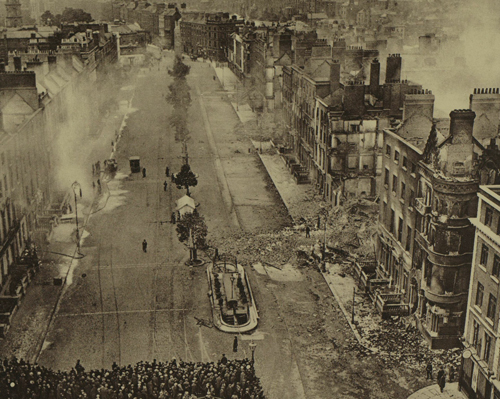Compensation claims mount as a result of Dublin destruction
Dublin, 22 July 1922 – Compensation claims have begun to flood in as a result of the destruction caused during the recent Battle of Dublin.
The total claimed in compensation has already reached £3.6m, though there appears to be confusion among claimants as to where they should be directing their claims – some are received at government offices and others by the town clerk and other local officials.
The single largest compensation claim – for £300,000 – was submitted by the Incorporated Law Society for the damage caused to the Solicitors’ Buildings in the Four Courts. Many other claims run into the hundreds and some are for amounts as small as £20.
The Mater Carnival Committee has submitted a claim for £1,541 for coats taken and the loss of a million tickets and envelopes, as well as orchestral sheet music and cash boxes. The Freeman’s Journal has issued a claim for £400, and Michael Finn of Main Street, Gorey, has sought £565 compensation for a motor car that was seized in Cahill’s garage in Donnybrook.
The addresses of the claimants are reflective of where most of the fighting took place in Dublin. They also reveal the extent to which visitors to the city were caught up in the violence. A New York couple, Mr and Mrs McGuire, who were staying at the Hammam Hotel on O’Connell Street and have registered a claim of £97 for lost or damaged goods, and a couple with the surname Malone from Tinahely in Co. Wicklow have each registered a claim of £100 for personal injuries.

Damaged gateway of the Four Courts (Image: Illustrated London News, 8 July 1922)
The destruction has not been confined to Dublin. As the fighting has spread to other parts of the country, the National Army has accused the Irregulars of carrying out an ‘extensive campaign of destruction and seizure of private property’, which has wreaked havoc on the social and economic life of the communities targeted.
It has been alleged by the National Army and by various press reports that in areas where anti-treaty forces are to be found in large numbers, railways have been destroyed, roads rendered impassable, and vehicles and provisions seized. In Wexford Town, the seizure of food, it was claimed, had led to cases of ‘actual want’.
In Limerick, a report issued by the National Army on 14 July alleged that ‘serious starvation’ was evident. The destruction of bridges and railroads and the blockade of highways has seriously hampered the transport of food in some areas in the south and west, and is inflicting worse suffering and privation upon the people than that experienced during the Black and Tan regime.
According to the report, the damage to the transport system in those parts of the country is estimated to come to many thousands of pounds, and has brought no gain to those responsible beyond satisfying the insensate desire to create a state of lawlessness and disorder in the country.
[Editor's note: This is an article from Century Ireland, a fortnightly online newspaper, written from the perspective of a journalist 100 years ago, based on news reports of the time.]





















